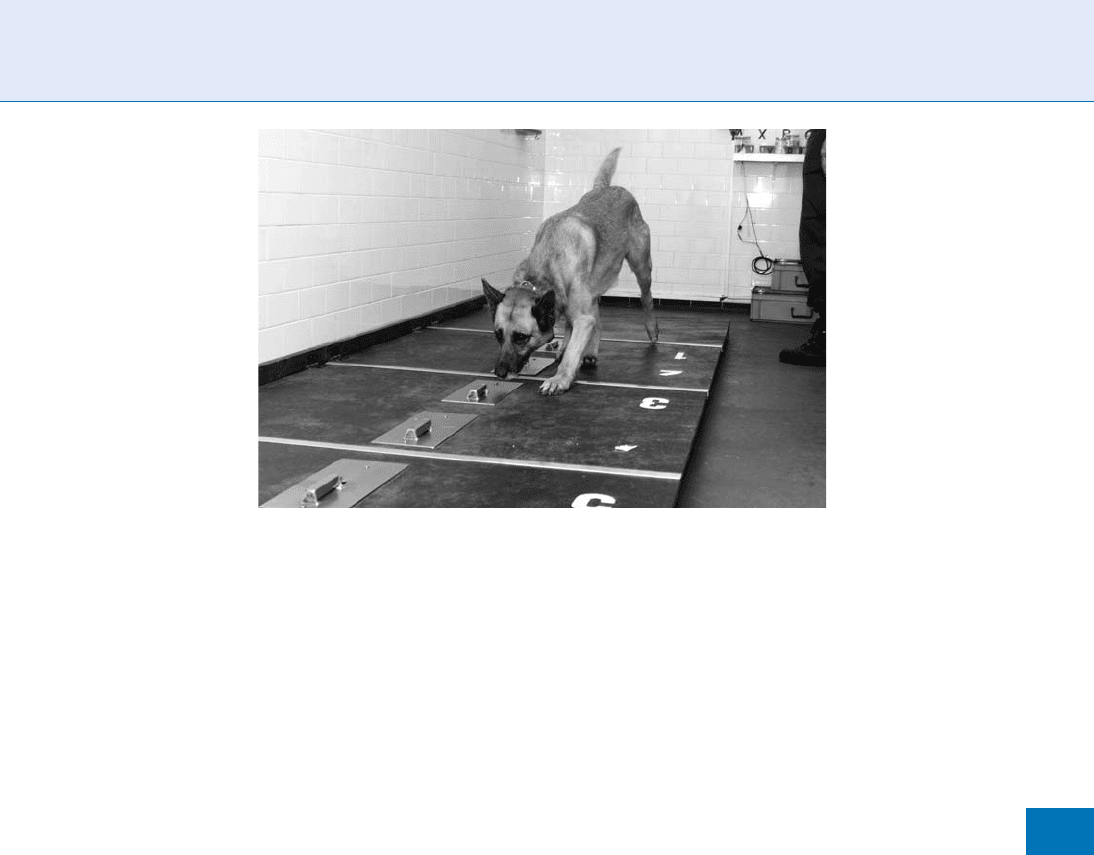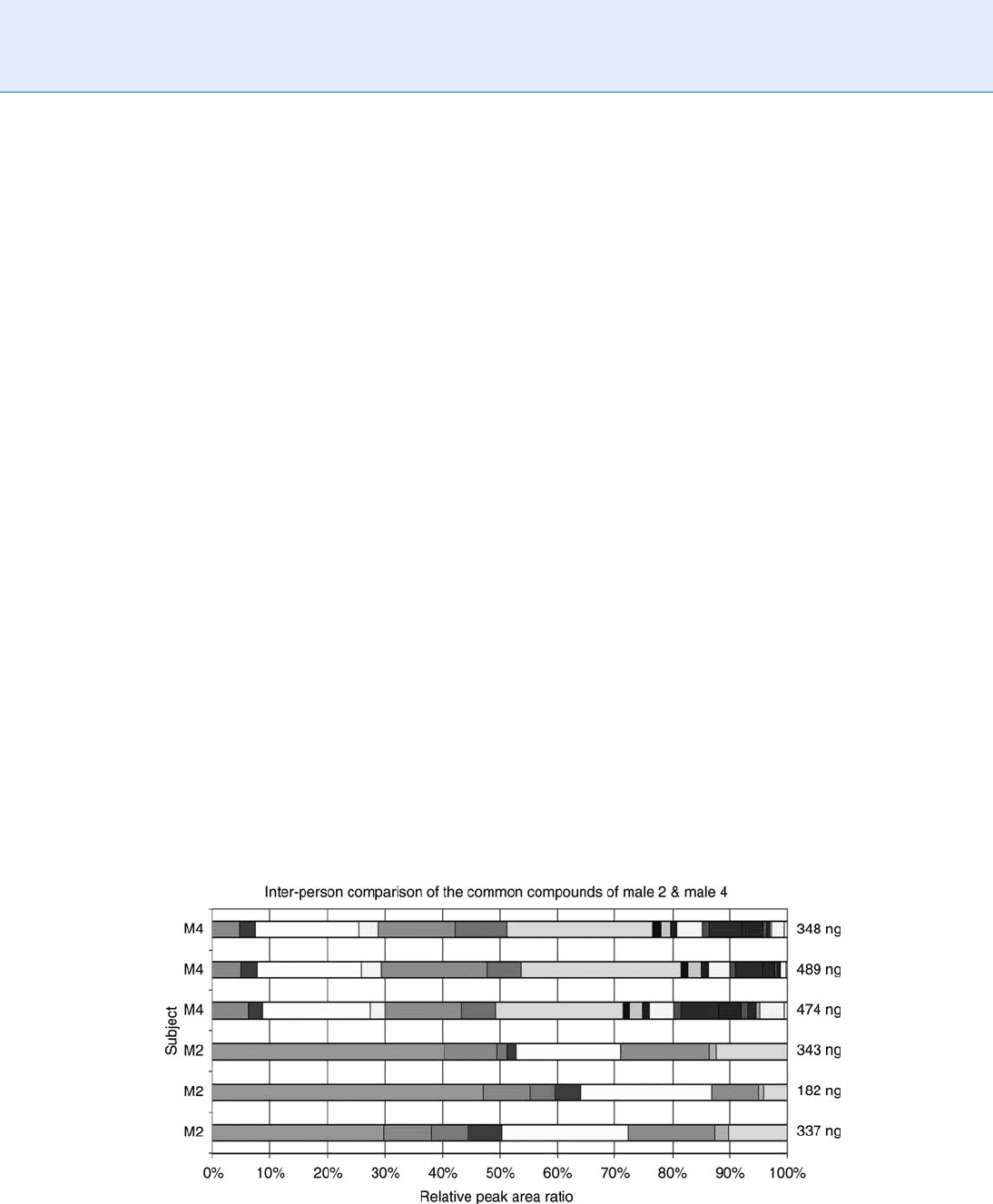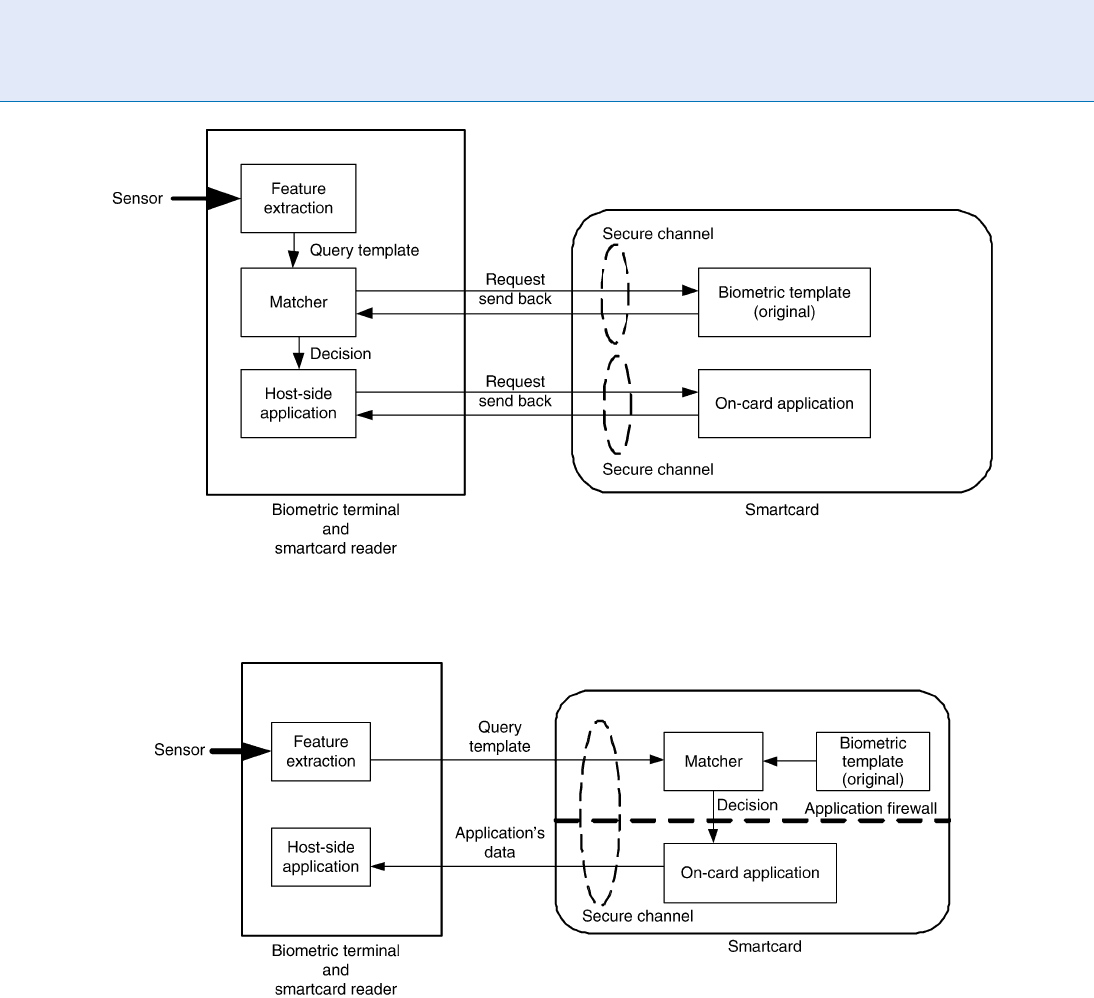Li S.Z., Jain A.K. (eds.) Encyclopedia of Biometrics
Подождите немного. Документ загружается.


‘‘track-sure’’: i.e., they continued to follow the specific
person in spite of chan ges in direction, ground sur-
face, and obstacles, in spite of other people having
crossed the path earlier or later. Such dogs could also
identify the person that had laid that track. This setup
is still followed today in the basic training of blood-
hounds all over the world. However, a more formalized
manner of working with dogs identifying human odors
has also evolved, primarily in Europe.
This formalized methodology is called ‘‘ sc ent identi-
fication line-up,’’ or ‘‘ osmology’’, and is applied as a
forensic identification tool in several European countries.
Dogs are trained to match the odor of a sample to its
counterpart in an array of odors. This can be done in
different ways [1, 2]. Generally the dog is given a scent
sample from a crime scene that presumably contains
the odor of the perpetrator. The odor of the suspect
and a number of foils, collected in a standardized
manner, are offered to the dog as the array. The dog
has to match the crime-scene related odor to that of
the suspect in the array, and indicate its choice w ith a
learned response. The methods and materials used to
collect human odor differ between countries; the exact
protocol for working with the dog differs; quality con-
trol measures necessary to validate the correctness of
the outcome differ; and the way in which the results are
evaluated and used during investigation and trial differ
between countries too. In spite of efforts to harmonize
these differences, they still exist since there is little
scientific evidence to select the ‘‘best’’ way: dogs per-
form best when tested in the way they were trained,
and much depends on how the dogs were sele cted and
trained.
From the little scientific work done using dogs
in this field, it became clear that dogs are capable of
matching odors collected from different body parts
[3, 4]. The series of experiments conducted by Schoon
and de Bruin [3], showed that trained police dogs
were capable of matching objects (stainless steel tubes)
held in the pocket or in the crook of the arm to
objects held by hand and vice versa significantly better
than chance, but that their performance was a lot better
on the comparison they trained often (pocket to hand:
58% correct in a 1 out of 6 comparison) than on a
comparison they never trained (crook elbow to hand;
hand to crook elbow: 32% correct in a 1 out of 6
comparison). Settle [4] had people scenting objects
(pieces of gauze) on numerous body parts and also
found dogs could match those that had been handled
by the same person significantly be tter than chance
(60% correct in a 1 out of 6 comparison). However,
the gauzes they used were stored together per person in
a glass jar prior the experiments with the dog, so they
may have all reached an equilibrium in this jar. Hepper
[5] found that dogs use odor cues that are under
genetic control more than those under environmental
control. He let dogs match the odor of T shirts of
fraternal and identical twins with identical or different
diets. When both diet and genes were identical, the
dogs could not differentiate between the twins (1 out
of 2 comparisons). When the genes were identical but
the diets differed, the dogs were able to differentiate
between the twins but they took a long time and their
choices were not very sure (83.5% correct in a 1 out of
2 comparison). When the genes were different but the
diets identical, the dogs performed best and made their
choices quickly and surely (89% correct in a 1 out of
2 comparison).
W ith advancing technology in the second half of
the twentieth century, an effort was made to identify
the source and composition of the body secretions that
made it possible for dogs to actually identify people
based on their odor. The human skin can be divided
into two layers: the outer la yer called the epidermis and
the inner layer called the dermis. The dermis layer con-
tains most of the specialized excretory and secretory
glands. The dermis layer of the skin contains up to
5 million secretory glands including eccrine, apocrine
and sebaceous glands [6]. Bacterial breakdown of apo-
crine secretions result in a huge number of volatile
compounds in armpits [7–9], but for forensic purposes
the breakdown of sebaceous gland sec retions is more
interesting since these products can be found on
crime-related objects such as guns, knives, crowbars,
gloves etc. Further study showed that trained dogs
are capable of matching objects scented by the same
person at different times but that their performance
was lower [10
].
Instrumental Differentiation Body
Scent
The individual body odors of humans are determined
by several factors that are either stable over time (ge-
netic factors) or vary with environmental or internal
conditions. The authors have developed distinguishing
terminology for these factors: the ‘‘primary odor’’ of an
1010
O
Odor Biometrics

individual contains constituents that come from with-
in and are stable over time regardless of diet or envi-
ronmental factors; the ‘‘secondary odor’’ contains
constituents which also come from within and are
present due to diet and environmental factors; and
the ‘‘tertiary odor’’ contains constituents which are
present because they were applied from the outside
(i.e., lotions, soaps, perfumes, etc.) [9]. There is a
limited understanding of how the body produces
the volatile organic compounds present in human
scent. Although the composition of human secre-
tions and fingerprint residues have been evaluated
for their chemical composition [6, 7], comparatively
little work has been done to determine the volatile
organic compounds present in human scent. Know-
ing the contents of human sweat may not accurately
represent the nature of what volatile compounds
are present in the headspace above such samples
which constitute the scent.
With the use of gas chromatography-mass spec-
trometry, an increasing number of volatiles were iden-
tified in the headspace of objects handled by people
[11]. Investigations into the compounds emitted by
humans that attract the Yellow Fever mosquito have
provided insight into the compounds present in
human odor. Samples were collected using glass
beads that were rolled between fingers. The beads
were then loaded into a GC and cryofocused by liquid
nitrogen at the head of the column before analysis
with
▶ GC/MS. The results showed more than 300
observable compounds as components of human
skin emanations, including: acids, alcohols, aldehydes,
and alkan es. The results also showed qualitative
similarities in compounds between the individuals
studied, however, quantitati ve differences were also
noted [11].
Until recently, technological limitations have re-
stricted the ability of researchers to identify the chemi-
cal components that comprise human scent without
altering the sample or to use the information to chem-
ically distinguish between individuals. In addition, it
has been difficult to distinguish between primary, sec-
ondary, and tertiary odor components in a collected
human scent sample.
▶ Solid phase micro-extraction
(SPME) is a simple solvent-free headspace extraction
technique which allows for
▶ volatile organic com-
pounds (VOCs) present in the headspace (gas phase
above an item) to be sampled at room temperature.
SPME in conjunction with GC/MS has been demon-
strated to be a viable route to extract and analyze the
VOCs present in the headspace of collected human
secretions. In a recent study, the hand odor of 60
subjects were studied (30 males and 30 females) and
63 human compounds extracted, there was a high
degree of variability observed with six high frequency
compounds, seven medium frequency compounds,
and 50 low frequency compounds among the popu-
lation. The different types of compounds determined
to be present in a human hand odor profile inclu-
ded acids, alcohols, aldehydes, alkanes, esters, ketones,
Odor Biometrics. Figure 1 Dog searching for a matching odor in a Dutch scent identification line-up (photo courtesy of
the Netherlands National Police Agency).
Odor Biometrics
O
1011
O

and nitrogen containing compounds. It has been
demonstrated that nonparametric methods of correla-
tion can be employed to differentiate between VOC
patterns from different individuals. In the 60 subject
study, it was shown that Spearman Rank Correlation
coefficient comparisons of human odor compounds
among individuals is a viable me thod of data handling
for the instrumental evaluation of the volatile organic
compounds present in collected human scent samples,
and that a high degree of distinction is possible among
the population studied [12]. Using a match/no-match
threshold of 0.9 produces a distinguished ability of
99.7% across the population. Other work also sho-
wed that multiple samples taken from the same per-
son showed that these could not be distinguished
at the sam e level. Fig ure 2 illustrate s the variation
of the VOC patterns in multiple samples from two
different males.
The genetic source of these specific human volatiles
has also been investigated. Experimental work with
dogs had already indicated a link to the genes of a
person, and work with rats and mice had located the
genes of the Major Histocompatibility Complex
(MHC) as the source of variation. The genetic basis
for individualizing body odors has been studied exten-
sively in genetically engineered mice which differ in
respect to the genes present in the MHC [13]. MHC
exhibits a remarkable genetic diversity with resulting
from a variety of characteristics including a level of
heterozygosity approaching 100% in natural popula-
tions of mice. This high level of heterozygosity seems
to be maintained by behavioral factors including mat-
ing success and associated with olfactory cues, and
chemosensory imprinting. In humans, the MHC is
referred to as the HLA, which is a short for human
leucocyte antigen. Experiments utilizing trained rats
have shown that urine odors of defined HLA-homozy-
gous groups of humans can be distinguished [13].
Individual body scents of mice can be altered by mod-
ification of genes within the MHC. Alterations to the
individual body scents of mice result in changes in the
concentrations of the volatile components found in
the urine [14]. Using two-dimensional GC/MS Willse
et al. were able to detect differences in the several dozen
MHC compounds (including 2,5-dimethylpyrazine
and 2-sec-butyl-4,5-dihydrothiazole) found in ether-
extracted urine from two inbred groups of mice that
differed only in MHC genes.
Legal Perspectives on Human Odor for
Forensic Purposes
In Europe, scent identification lineups have been used
routinely by police forces, for example in Poland and
The Netherlands, and the results have been the subject
of discussion and different interpretations in court. In
Poland Wo
´
jcikiewicz [15] summarized a number of
court cases where dog evidence was critically reviewed.
Generally, the evidence was accepted by Polish courts
as ‘‘additional evidence,’’ thus allowing the results to be
used only if convergent with other evidence; a point
Odor Biometrics. Figure 2 Illustration of the variety in volatile organic compounds as collected by SPME and determined
by GC-MS from three samples of two human subjects. Each color is a different VOC.
1012
O
Odor Biometrics

of view of Wo
´
jcikiewicz, given the limited scientific
background knowledge at that time. In the Nether-
lands, scent lineup evidence has been the subject of
much debate over the years. A recent case confirmed
that results from carefully conducted scent identifica-
tion lineups can be used as an addition to other evi-
dence [16]. In the absence of the other evidence, a
positive result of such a lineup is regarded as insuffi-
cient evidence for conviction.
The twenty-first century has brought with it two
important case decisions in the United States Court
System pertaining to the use of human scent canines in
criminal prosecutions. In 2002, the U.S. Court System
decided human scent canine associations could be
utilized through the introduction of expert witness
testimony at trial if the canine teams were shown to
be reliable [17]. In 2005, a Kelley hearing in the state of
California [18] set a new precedent in the U.S. which
allowed human scent identi fication by canine to be
admitted as forensic evidence in court as opposed
to being presented as expert witness testimony. The
California court ruled that human scent discrimina-
tion by canine can be admitted into court as evidence
if the person utilizing the technique used the correct
scientific procedures, the training and expertise of the
dog-handler team is proven to be proficient, and
the methods used by the dog handler are reliable.
Summary
The scientific studies to date support the theory that
there is sufficient variability in human odor between
persons and reproducibility of primary odor com-
pounds from individuals that human odor is a viable
biometric that can be use d to identify persons. The
bulk of the available literature is based on the ability of
training dogs to identify objects held by a specific
person but advancing technology has recently made it
possible to differentiate humans based on headspace
analysis of objects they have handled supporting the
results seen with dogs. With additional research and
development on training and testing protocols w ith
the dogs, and instrumental methods, the future of
human odor as an expanded biometric is quite
promising. In addition, unlike many other biometrics,
human scent can be detected from traces, such as skin
rafts, left by a person and can be collected in a nonin-
vasive fashion.
Related Entries
▶ Human Scent and Tracking
▶ Individuality
References
1. Schoon, A., Haak, R.: K-9 suspect discrimination: Training and
practicing scent identification line-ups. Detselig, Calgery, AB,
Canada (2002)
2. Schoon, G.A.A.: Scent identification line-up by dogs (Canis
Familiaris): Experimental design and forensic application.
Appl. Anim. Behav. Sci. 49, 257–267 (1996)
3. Schoon, G.A.A., De Bruin, J.C.: The Ability of dogs to recognize
and cross-match human odours. Forensic Sci. Int. 69, 111–118
(1994)
4. Settle R.H., Sommerville, B.A., McCormick, J., Broom, D.M.:
Human scent matching using specially trained dogs. Anim.
Behav. 48(6), 1443–1448 (1994)
5. Hepper, P.G.: The discrimination of human body odour by the
dog. Perception 17(4), 549–554 (1998)
6. Ramotowski, R.S.: Comparison of latent print residue.
In: Lee, H.C., Gaensslen, R.E. (eds.) Advances in Fingerprint
Technology, 2nd edn. pp. 63–104. CRC Press, Boca Raton, FL
(2001)
7. Shelley, W.B., Hurley, H.J. Jr., Nichols, A.C.: Axillary odor:
Experimental study of the role of bacteria, apocrine sweat
and deodorants. AMA Arch. Derm. Syphilol. 68(4), 430–446
(1953)
8. Sommerville, B.A., Settle, R.H., Darling, F.M., Broom, D.M.: The
use of trained dogs to discriminate human scent. Anim. Behav.
46, 189–190 (1993)
9. Curran, A.M., Rabin, S.I., Prada, P.A., Furton, K.G.: Comparison
of the volatile organic compounds present in human odor using
SPME-GC/MS. J. Chem. Ecol. 31(7), 1607–1619 (2005)
10. Schoon, G.A.A.: The effect of the ageing of crime scene objects
on the results of scent identification line-ups using trained dogs.
Forensic Sci. Int. 147, 43–47 (2005)
11. Bernier, U.R., Booth, M.M., Yost, R.A.: Analysis of human skin
emanations by gas chromatography/mass spectrometry. 1. Ther-
mal desorption of attractants for the yellow fever mosquito
(Aedes aegypti ) from handled glass beads, Anal. Chem. 71(1),
1–7 (1999)
12. Curran, A.M., Ramirez, C.R., Schoon, A.A., Furton, K.G.: The
frequency of occurrence and discriminatory power of com-
pounds found in human scent across a population determined
by SPME-GC/MS. J. Chromatogr. B 846, 86–97 (2007)
13. Eggert, F., Luszyk, D., Haberkorn, K., Wobst, B., Vostrowsky, O.,
Eckhard Westphal, E., Bestmann, H.J., Mu
¨
ller-Ruchholtz, W.,
Ferstl, R.: The major histocompatibility complex and the che-
mosensory signalling of individuality in humans. Genetica 104,
265–273 (1999)
14. Willse, A., Belcher, A.M., Preti, G., Wahl, J.H., Thresher, M.,
Yang, P., Yamazaki, K., Beauchamp, G.K.: Identification of
major histocompatibility complex-regulated body odorants by
Odor Biometrics
O
1013
O

statistical analysis of a comparative gas chromatography/mass
spectrometry experiment. Anal. Chem. 77, 2348–2361 (2005)
15. Wo
´
jcikiewicz, J.: Dog scent lineup as scientific Evidence. Pro-
blems of Forensic Sciences 41, 141–149 (2000)
16. LJN: AW0980, 11th April 2006, Helderse Taximoord
17. California v. Ryan Willis, MA020235, June (2002)
18. California v. Salcido, Cal. App. 2nd, GA052057 (2005)
Off-Angle or Nonorthogonal
Segmentation
▶ Segmentation of Off-Axis Iris Images
On-Card Matching
CHEN TAI PANG
1
,YAU WEI YUN
1
,XUDONG JIAN G
2
1
Institute for Infocomm Research, A*STAR, 21 Heng
Mui Keng Terrace, Singapore
2
Nanyang Technological University, 50 Nanyang
Avenue, Block S2-B1c-105, Singapore
Synonyms
Biometric Match-on-Card, MOC ; Work-Sharing
On-card Matching
Definition
On-card matching is the process of performing com-
parison and decision making on an integrated circuit
(IC) card or smartcard where the biometric reference
data is retained on-card to enhance securit y and
privacy. To perform enrolment, the biometric interface
device captures the biometric presentation of the user
to create the biometric
▶ template. Then, the biomet-
ric template and user’s information are uploaded to the
card’s secure storage. To perform on-card matching,
the biometric interface device captures the biometric
presentation and creates a biome tric template. The
created biometric t emplate is then uploaded to the
card for verification. The verification process shall
be executed on-card instead of sending the enrolled
template out of the card for verification.
Introduction
The need for enhanced security persists more than ever
in a more electronically dependent and interconnected
world. The traditional authen tication method, such as
PIN, is neither secure enough nor convenient for auto-
matic identification system such as border control.
Our economic and social activities in today’s electronic
age are getting more reliant to electronic transactions
that transcend geological and physical boundaries.
These activ ities are suppor ted by implicitly trusting
the claimed identity – with we trusting that the part y
we are transacting with is genuine and vice versa.
However, conventional password and Personal Identi-
fication Number (PIN) commonly used are insecure,
requiring the user to change the password or PIN
regularly. Biometric technology uses a person’s unique
and permanent physical or behavioral characteristics
to authenticate the identity of a person. Higher level of
security can be provided for identity authentication
than merely the commonly used PIN, password or
token. Some of the popular biometric technologies
include fingerprint, face, voice, and iris. All biometric
technologies share a common process flow as shown in
(Fig. 1) below.
Fig. 1 shows the basic architecture of biometric
authentication with a central database. In order to
use the biometric system to identify a person, he or
she will have to enroll in the system’s database. The
system has to create and maintain the biometric data-
base in a central PC or server. Even for a biometric
door access system (no matter for home use or office
use), a small biometric database is stored in the
embedded unit. Usually this is not a problem for
home use because only the owner or trusted person
can have access to the database. But what about the
other service providers? If hackers can access some of
the confidential database information of big corpora-
tions such as Bank of America, LexisNexis, T-Mobile
[1] and the security breach affecting more than 200,000
credit card holders [2] who then can the user trust?
Since biometric data is permanent and each person has
limited amount of choice (a person only has a face and
10 fing ers), having the biometric database information
stolen is a serious implication to the actual owner. One
of the alternatives is to store the biometric template
into a smartcard. Smartcard is a plastic card with
microprocessor inside to handle the data storage and
has processing capability with security features. Hence,
1014
O
Off-Angle or Nonorthogonal Segmentation

the combination of biometrics and smartcard offers
enhanced security for identity authentication.
Biometrics and Smartcard
Instead of relying on a centralized databas e system and
allowing individual service provider to create its own
biometric database, the biometric information can be
kept in the hand of the respective owner of the biomet-
ric data. This can be done by putting the biometric
data into a secure storage such as a smartcard. Smart-
card is a plastic card with an embedded microproces-
sor, memory and, security features. The user can
conveniently carry the smartcard, and thus it also
offers mobility to biometric data. The combination of
biometric and smartcard offers the advantages of mo-
bility, security and strong identity authentication
capability and, at the same time offers the user, a
high degree of control over who have access to that
biometric data. Hence, biometrics on the smartcard
can minimize the privacy concern. There are four
distinct approaches to combine the smartcard and
biometric technologies as follows:
1. Template-On-Card (TOC): This type of matching is
also known as off-card matching. The entire pro-
cess of biometric data acquisition, feature extrac-
tion, and matching is done at the terminal or reader
side. However, during the enrolment stage, the
original templa te which is constructed at the reader
is stored inside the smartcard. During matching ,
the reader will request for the original template
to be released from the smartcard which is then
matched with the query template. The decision of
further accessing information from the smartcard
is made on the reader side. The smartcard itself act
as a storage device. Cryptography should be used to
mutually authenticate the card and the biometric
interface device. To protect the communication
between the biometric interface device and the
card; a secure channel should be established prior
to the transfer of any template or data. As the
biometric template and other data objects such as
passport/visa or financial account information are
stored as a separate file in the smartcard, separate
secure channels can be used for transmitting differ-
ent data object. Fig. 2 shows the basic architecture
of TOC.
2. Match-On-Card (MOC): MOC means the biomet-
ric verification is performed in the card. The pro-
cess of biometric data acquisition and feature
extraction is done at the biometric terminal. Dur-
ing the initial enrolment stage, the original tem-
plate constructed at the reader is stored inside the
smartcard. During matching, the reader will con-
struct the query template which is then sent to the
smartcard for matching. The final matching deci-
sion is computed inside the smartcard and thus the
entire original template is never released from the
smartcard. Fig. 3 shows the authentication process
of a MOC system for a simple case of border con-
trol transaction. The dotte d line in the figure is the
applet firewall which restricts the access to the
matching applet to enquire the status of fingerprint
authentication. Therefore, the matching result will
be sent from the Matcher to the on-card applica-
tion by secured sharable method via smartcard
operating system. Neither the original template
nor the matching result is revealed to the outside
world. In order to protect the communication bet-
ween the biometric interface device and the card,
a secure and trusted channel is required.
3. Work-Sharing On-Card Matching:
▶ Work-sharing
on-card matching is similar to on-card matching
except for extra matching procedures are involved
On-Card Matching. Figure 1 Process flow involved in a common biometric system.
On-Card Matching
O
1015
O

to speed up the process. This type of matching is
designed for those cards which do not have suffi-
cient processing power and resources to execute
the biometric matching. In this case, certain parts
which are compu tation intensive such as template
alignment, are sent to the biometric terminal via
communication channel to perform computation.
The computed intermediate result is sent back to
the smar tcard to continue with the matching pro-
cess. The final calculation of the matching score
shall be calculate d inside the smartcard. Establish-
ing a secure channel is required to protect the
communication between the biometric terminal
and the smartcard. Fig. 4 shows the basic architec-
ture of work-sharing on-card matching.
4. System-On-Card (SOC):
▶ System-on-card match-
ing means the whole biometric verification process,
including the acquisition, is performed on the
smartcard. The smartcard incorporates the entire
biometric sensor, with processor and algorithm.
Therefore, the entire process of biometric data ac-
quisition, feature extraction, and matching is
done inside the smartcard itself. Both the original
template and the query template are computed
On-Card Matching. Figure 2 Template-on-card authentication.
On-Card Matching. Figure 3 Match-on-card authentication.
1016
O
On-Card Matching

in the smartcard and do not leave the card. Fig. 5
shows the general authentication process of a
SOC system.
Advantages of Match-on-Card
The level of security of a biometric system is judged by
examining where the feature extraction and matching
takes place. From the point of view of security, system-
on-card (SOC) offers the strongest security while
template-on-card (TOC) offers the weakest secure for
token based authentication [3]. It is obvious that the
SOC offers the highest security since the biometric
authentication process, including acquisition of bio-
metrics, is executed inside the smartcard itself and no
biometric data is transferred out of the smartcard. How-
ever, the cost of such smartcard will be high since the
card contains a biometric sensor and requires a powerful
processor (usually 32-bit) to meet the computational
demand of the biometric processing. Therefore, SOC is
still not practical for mass issuing and is usually suitable
for vertical market only. This means that the match-on-
card (MOC) technology which offers a higher security
than the TOC technology at reasonable price and is
a more practical solution. There are a lot of commercial
implementations for fingerprint, face, and iris. Finger-
print MOC is the most popular in market due to good
On-Card Matching. Figure 4 Work-sharing On-card matching.
On-Card Matching. Figure 5 System-on-card authentication.
On-Card Matching
O
1017
O

accuracy, ease of use, affordability, and an overall com-
pact solution.
The reasons why the match-on-card (MOC) tech-
nology provides better security in comparison to
template-on-card (TOC) technology are:
1. Better Security and Privacy Protection: TOC needs
to send the enrolment template from the card to
the biometric terminal for verification. The security
is compromised due to information exposure. Even
though the template is usually encrypted, the
on-card crypto engine is usually not very strong
due to constrained hardware specification of the
smartcard’s CPU. For the MOC case, the reader
will send the query template to the smartcard for
identity verification. Therefore, the MOC technol-
ogy does not reveal the entire original biometric
template stored in the smartcard. During the
matching process, the stored original template is
always trusted since the smartcard is considered a
secure storage device. Moreover, better privacy pro-
tection can be provided by match -on-card as no
one can download the user’s enrolment fingerprint
template from the card.
2. Two Factor Authentication: MOC technology will
establish a true two-factor authentication process
for the identity authentication needs. No matter
MOC or TOC, to start communication between
smartcard and reader securely, a secure channel
shall be established with mutual authentication
before any transaction takes place. This stage is to
allow the reader and the smartcard to verify the
cryptogram from each side to ensure both reader
and smartcard are valid and genuine. However,
this stage relies on exchanging challenge code be-
tween card and reader. Once the challenge code
is stolen by Trojan, hacker may be able to access
the smartcard and continue to do further hacking
procedures. For TOC, if the first stage is cracked,
the hacker will be able to access secured informa-
tion in the card. For MOC, if the first stage is
cracked, the hacker will still need to hack the sec-
ond stage of biometric MOC stage in order to
continue to access secured information. Hence,
MOC offers true two-factor authentication which
can provide stronger security to protect against
hacking.
3. On-Card Decision Making, Stronger Software Secu-
rity: In figure 3, the on-card matcher sends the
decision to other on-card application internally
via a software firewall that is controlled by the
smartcard Operating System (OS). Such internal
decision passing via firewall is a strong security
feature and very difficult to be hacked. Note that
the installation of on-card application is usually
done in the factory (ROM masking), in OS provider
of the smartcard or in authorized agency with
security code for installation. After installing all
necessary applications, it is possible to lock the
card forever to prevent installing other application
in the future. Each application has restriction
to access resources from other applications and
usually controlled by the smartcard OS. Among
the trusted applications, they can send and receive
information among them via the firewall with se-
curity code. Hence, it is very difficult for hacker to
upload Trojan to the card to hack the internal
invocation between applications, stealing internal
information from the card and sending fake deci-
sion from the MOC to fool other on-card applica-
tions to leak crucial information.
Implementations of Fingerprint
Match-On-Card
In recent years, there are quite a number of attempts to
design algorithm to perform fingerprint match-on-
card application. Mohamed [4] proposed a memory
efficient scheme of using line extraction of fingerprint
that could speed up the matching process. However,
this approach still needs a 32-bit DSP to process and
the computation is still relatively intensive for com-
mercial a smartcard. Vuk Krivec et al. [5] proposed a
hybrid fingerprint matcher, which combines minutiae
matcher and homogeneity structure matcher, to per-
form authentication with smartcard the system. Their
method is to perf orm minutiae match-on-card first.
Upon successful minutiae matching, the card delivers
rotational and translational paramet ers to the sys-
tem to perform second stage homogeneity structure
fingerprint matcher on the host side. However, this
hybrid approach cannot increase the accuracy signifi-
cantly compared to minutiae matcher alone but using
extra time to perform extra host side matching. Andy
Surya Rikin et al [6] proposed using minutia ridge
shape for fingerprint matching. The ridge shape infor-
mation is used during the minutiae matching to
1018
O
On-Card Matching

improve the matching accuracy. In their experiment,
only 64 bytes per template was used. They showed that
the accuracy was comparable with the conventional
matching but having a faster matc hing speed. The
matching time on a 16-bit smartcard was around 1.2
seconds with 18 minutiae. Mimura M. et al. [7] de-
scribed a method of designing fingerprint verification
on smartcard with encryption functions to enable ap-
plication using on-card biometrics to perform transac-
tion via Internet. Stefano Bistarelli et al. [8] proposed a
matching method using local relative information
between nearest minutiae. This method could achieve
matching time from 1 to 8 seconds with 10% ERR
on average using FVC2002 database. All the above
attempts were to implement fingerprint matching on
native smartcard or Java card in the research commu-
nity. Generally speaking, it is not easy to achieve good
accuracy with low computation requirement for on-
card fingerprint matching. Besides good matc hing
algorithms, software optimization is also an important
criterion to develop MOC system to achieve fast on-
card matching speed.
Of course, there are several commercial implemen-
tations for fingerprint MOC. Most of them are using
minutiae data for verification of identity. Those com-
panies usually provide the accuracy information of False
Acceptance Rate = 0.01% and False Rejection Rate =
0.1%. No further information regarding the database,
method of calculation, and other details have been
disclosed. Hence, it is not possible to tell the actual
accuracy of those commercial implementations using
their provided specification. Currently, the only reli-
able benchmarking is using common database such as
Fingerprint Verification Competition (FVC) fingerprint
database or National Institute for Standardization and
Technologies (NIST) fingerprint database to compare
the other system by using common performance indica-
tors such as False Match Rate (FMR), False Non-Match
Rate (FNMR), Equal Error Rate (ERR) and Receiver
Operation Curve (ROC) to compare the relative per-
formance among MOC implementations.
Performance of Fingerprint
Match-on-card
In 2007, NIST conducted an evaluation for the per-
formance of fingerprint match-on-card algorithms -
MINEX II Trial. The aim of MINEX II trial was to
evaluate the accuracy and speed of the match-on-card
verification algorithms on ISO/IEC 7816 smartcards.
The ISO/IEC 19794-2 compact card fingerprint minu-
tiae format was used in the test. The test was conducted
in 2 phases. Phase I was a preliminary small scale test
with release of repor t only to the provider. Phase II was
a large scale test for performance and interoperability.
Initially, 4 teams participated in the Phase I. In the
final Phase II test, three teams were participated in
the test. The Phase II report was published on 29th
February 2008 [9]. Some highlights of the result are
stated below:
The most accurate match-on-card implementation
executes 50% of genuine ISO/IEC 7816 VERIFY
commands in 0.54 seconds (median) and 99%
within 0.86 seconds.
The False Non-Match Rate (FNMR), at the indus-
trial preferred False Match Rate (FMR) = 0.01%, is
2 to 4 times higher than FMR at 1%.
Using OR-rule fusion at a fixed operating thresh-
old, the effect of using a second finger only after a
rejection of the first, is to reduce false rejection
while increasing false acceptance.
The most accuracy implementation satisfies only
the minimum requirements of the United States’
Government’s Personal Identity Verification (PIV)
program.
Some cards are capable of accepting more than
60 minutiae for matching. Some cards need minu-
tiae removal for either or both of the reference and
verification templates prior to transmission to the
card. It was discovered that the use of minutiae
quality values for removal is superior to using the
radial distance alone.
In this evaluation, only 1 team can achieve the mini-
mum requirement of PIV program. Hence, compared
to off-card matching, it is necessary to further improve
the accuracy for those applications that require
PIV specification such as immigration. As the compact
card format is the quantized version of the normal
size finger minutiae format, the performance is still
unknown of using the normal format in MOC. Num-
ber of existing commercial implementations are using
fingerprint minutiae proprietary format for MOC im-
plementation. MINEX II continues the Phase III in
2008 to gauge improvements over existing implemen-
tations and to ev aluate others.
On-Card Matching
O
1019
O
